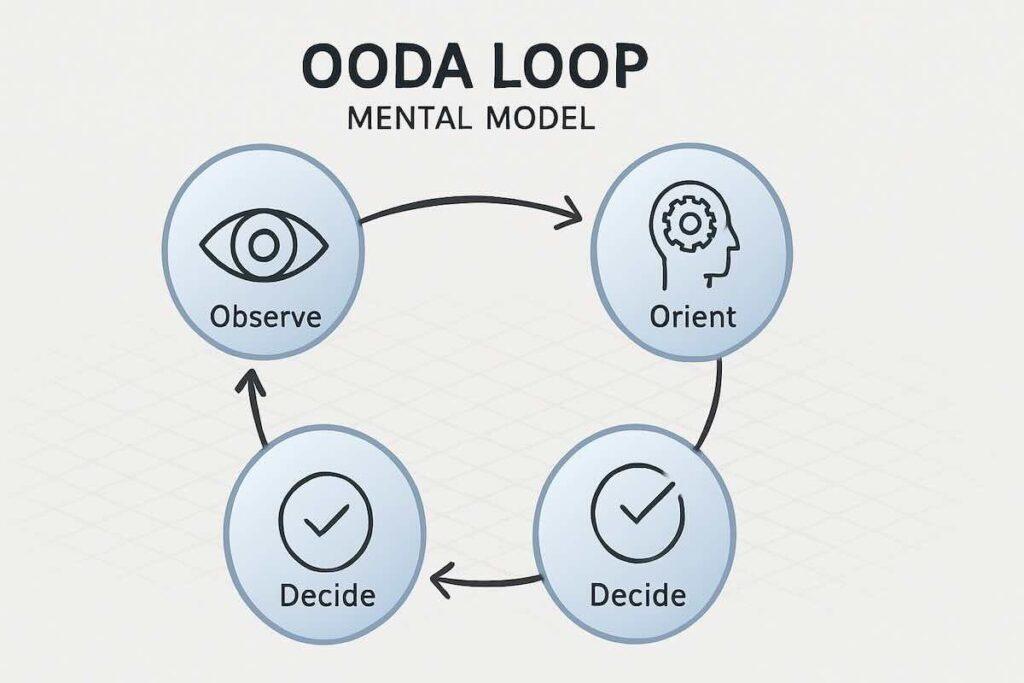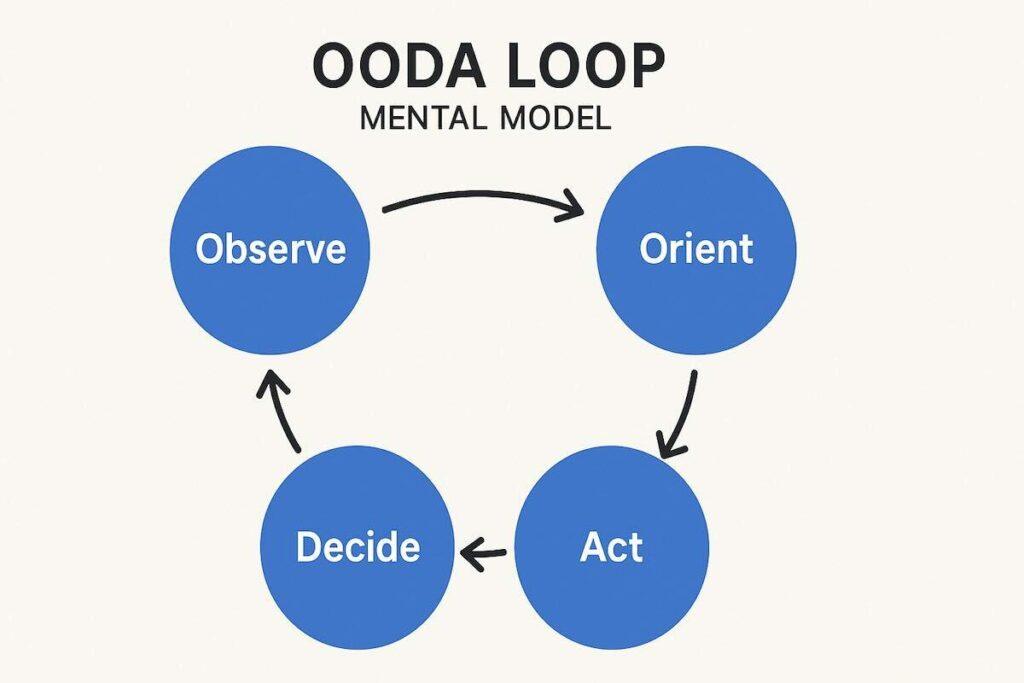The OODA Loop mental model was created by U.S. Air Force Colonel John Boyd. It’s a framework for making quick decisions. It was first used by fighter pilots to outmaneuver opponents.
Now, it’s used in business, crisis management, and leadership. The OODA Loop helps you adapt fast, stay aware of your surroundings, and learn from mistakes. It’s useful for making decisions in uncertain situations.
Whether you’re in a boardroom or dealing with a crisis, the OODA Loop Mental Model is a four step process that helps you stay ahead. We’ll look into its origins, its four phases, and how leaders in top companies use it to succeed worldwide.
Key Takeaways
- Ooda loop mental model: Created by military strategist John Boyd to improve real-time decision-making
- Four phases: Observe, Orient, Decide, Act—repeatable in any situation
- Speed and adaptability matter more than perfect information
- Effective in business, personal growth, and fast-changing environments
- Built on two core ideas: competition exists everywhere, and momentum creates advantage
Whether you’re pivoting a project or navigating life’s surprises, this mental model keeps you moving forward. Let’s break down how it works—and how you can master it.
History and Evolution of the OODA Loop
How did a fighter pilot’s observations change military tactics forever? The answer lies in the story of Colonel John Boyd—a man who turned combat experience into a blueprint for winning through the ooda loop, a framework that emphasizes how to make decisions effectively.
Colonel John Boyd and the Origins
Boyd wasn’t just a skilled fighter pilot. As a military strategist, he noticed something odd during training: pilots with older planes often outperformed those with advanced jets. By studying dogfight records, he realized victory hinged on faster decisions, not better technology.
This insight became the spark for his framework. Boyd’s dual role—combat veteran and analytical thinker—let him see patterns others missed. He discovered that adapting quickly to new information created unstoppable momentum.
Military Applications and the Korean War
The proof came in the skies over Korea. U.S. pilots achieved a jaw-dropping 10:1 victory ratio against opponents. Their secret? Shortening decision cycles. While enemies froze to assess situations, American teams acted, adjusted, and attacked again.
Boyd’s concept of “getting inside” an opponent’s process reshaped modern strategy. Today, leaders use his principles to stay ahead in fast-moving competition. What could you achieve by thinking like a pilot under pressure?
OODA Loop: Observe, Orient, Decide, Act

Think of these four stages as your compass in stormy seas. They guide you from confusion to clarity—even when waves of uncertainty crash around you.
This is where the OODA loop comes into play, serving as a crucial part of the scientific method for making decisions and determining the best course of action to achieve desired results in any environment.
The Role of Observation and Orientation
Observation isn’t just about collecting data—it’s hunting for patterns. Picture a chef tasting a dish mid-preparation. They notice if flavors balance, adjust spices, then taste again. Your goal? Gather what matters without drowning in details.
Orientation turns raw ingredients into a meal. Here, you question assumptions: “Is this data reliable?” or “What biases might skew my view?” A marketing team, for example, might realize their survey overlooks younger audiences—a blind spot costing them growth.
Decision & Action: Applying the OODA Loop

Decisions without action are just ideas. The real strength of the OODA Loop mental model shows up when we move from idea to action. After we observe and orient, we quickly test our decisions in real life.
Think about emergency teams in crises. They don’t wait for perfect information. They act with the best data they have, then check again. This cycle of choosing and doing keeps things moving and avoids getting stuck.
In startups, launching a minimum viable product (MVP) is a key example. It lets them get feedback to improve and steer their direction.
The beauty of this model is its ability to adapt. Even if our first decisions aren’t perfect, they can give us valuable feedback. This feedback helps us improve in the next cycle. So, action is not just the last step but the start of learning again.
Real-World Applications of the OODA Loop Mental Model
What separates thriving companies from struggling ones in turbulent markets? Often, it’s their ability to pivot faster than problems arise, using a course of action that exemplifies the OODA Loop. This framework isn’t just theory—it’s reshaping how people and teams operate and win.
Business Applications and Competitive Advantage
Take Amazon’s pricing strategy. Their systems track customer behavior hourly, adjust inventory in real time, and launch targeted promotions—all while competitors still analyze last week’s data. A Harvard study found companies using rapid decision cycles are 70% more likely to lead their industries.
Software teams apply this during sprint reviews. After each development phase, they ask: “What worked? Where did we get stuck?” These insights fuel immediate adjustments, cutting wasted effort by 40% in some cases.
Agile Methods and Crisis Decision-Making
When a major retailer faced a data breach, their team resolved it in 12 hours—not days. How? They observed the breach scope, oriented by consulting cybersecurity experts, decided on system shutdowns, and acted before panic spread.
| Situation | Traditional Response | OODA-Based Response |
|---|---|---|
| Product Recall | Weeks of internal reviews | 48-hour containment plan |
| Supply Chain Disruption | Wait for market stabilization | Source alternative vendors in 3 days |
| Negative PR Crisis | Delayed public statement | Address media within 6 hours |
Leaders who master this structured approach build organizations that adapt like living systems. Could your team benefit from turning uncertainty into momentum?
Accelerating Decision Cycles: Speed and Timing

Ever been stuck between rushing a choice and waiting too long? Modern strategists reveal a game-changing insight: speed and timing aren’t the same. While quick reactions win dogfights, patience often triumphs in boardrooms, providing a crucial way to make decisions in competitive environments.
This highlights the importance of understanding the right course of action as part of effective mental models in the business world.
Fighter Pilot Examples Versus Business Scenarios
In air combat, pilots have milliseconds to dodge missiles. Every cycle—observe threats, adjust course, fire—decides survival. Yet business leaders face different clocks. Launching a product too fast might miss market readiness. Waiting too long lets competitors strike first.
Tech giants like Google balance both worlds. Their teams use rapid testing for features but delay full launches until cultural trends align. A structured approach helps them spot when to sprint versus pause.
Impact on Competitive Environments
Racing through cycles creates chaos for opponents. Retailers like Zara refresh designs weekly, leaving rivals scrambling. But speed without strategy backfires. One startup lost investors by pivoting too often—they forgot to time their moves with industry shifts.
Ask yourself: Does your team’s rhythm match the situation? Sometimes moving slower breaks the opponent’s momentum. Other times, quick pivots trap them in reactive mode. Master both, and you control the game.
Enhancing Agility with the OODA Loop
What if every decision made you smarter for the next challenge? That’s the magic of strategic agility—not just reacting faster, but learning better through effective mental models.
At its core lies a simple truth: improvement happens through feedback, not just action, as part of a continuous process in the OODA loop.
Feedback Loops and Continuous Improvement
Think of feedback like a chef tasting soup mid-cook. Each adjustment—more salt, less heat—sharpens the final dish. In decision-making, every outcome teaches something new. A sales team might notice clients respond better to visuals than spreadsheets. That insight becomes fuel for their next pitch.
Here’s the twist: feedback doesn’t flow in straight lines. Like rivers branching through a forest, information takes multiple paths. A structured approach helps map these routes. One tech company reduced errors by 30% after creating three parallel feedback channels: customer surveys, team retrospectives, and real-time analytics.
Orientation acts as the central hub. It’s where you compare new data with existing knowledge. Imagine a doctor diagnosing a rare illness—they cross-reference symptoms with medical databases while listening to the patient’s story. Strengthen this phase, and your entire process gains precision.
Agile teams thrive this way. After each project sprint, they ask: “What surprised us? What patterns emerged?” These lessons shape their next moves. Over time, they build mental models that predict market shifts weeks before competitors notice.
How could you design faster learning cycles today? Start small: review one daily decision and note what you’d change next time. Progress compounds when reflection becomes habit.
The Theory of Constraints fits well here. It helps teams find and fix bottlenecks in the feedback loop. This improves how well the system works.
Challenges and Criticisms of the OODA Loop

Even powerful tools have edges—sharp ones. While this framework shines in fast-paced scenarios, such as those described in the OODA Loop, it stumbles when stretched beyond its original design.
Like a race car built for tight turns, it struggles on rocky terrain, illustrating a clear example of how a misaligned course of action can lead to inefficiencies in applying mental models.
When Teams Outgrow Solo Strategies
The method works brilliantly for individuals. But organizations face different physics. Imagine ten chefs trying to taste the same soup simultaneously—chaos ensues. Alignment slows cycles. A sales team might spot a market shift, but legal reviews stall action for weeks.
Modifications help. Some companies create parallel decision streams. Others designate “cycle captains” to maintain momentum. The core idea remains, but execution demands new ways of collaborating.
The OODA Loop Mental Model: Speed Traps and Hidden Costs
Quick choices can save companies—or sink them. A tech startup once rushed a feature launch to beat competitors. They won the race but lost user trust through buggy updates. Decisions made in haste often ignore long-term consequences.
Not every situation needs lightning responses. Mergers, ethical dilemmas, and safety protocols require deliberation. The model works best when paired with other tools—like using both accelerator and brake pedals during a storm.
How do you balance urgency with wisdom? Start by asking: “What’s the cost of being wrong?” Sometimes moving slower today prevents disasters tomorrow.
This is a good place to apply the Second-Order Thinking Mental model. The OODA Loop helps you act quickly. But Second-Order Thinking makes sure you think about the long-term effects. This balance of speed and foresight is very powerful.
When the OODA Loop Meets Organizational Bureaucracy
Big companies often find it hard to use the OODA loop because of slow processes. Getting legal okay, aligning departments, and breaking down data silos can slow things down. Even when teams see important trends, decisions get stuck in committees.
To fix this, some firms choose “loop leaders” or teams that can act fast. This idea is like the military’s way of working, where teams can make decisions on their own. The main problem is finding a balance between being quick and following rules. This is a constant challenge for many businesses.
Conclusion
The OODA Loop mental model continues to prove its value in today’s fast-paced world. From fighter pilots to tech executives, those who master this decision-making cycle gain a critical edge in navigating uncertainty.
The model’s power lies in combining awareness, speed, and iterative learning.
By building feedback loops into every decision, teams can respond faster, course-correct smarter, and maintain strategic momentum.
Whether you’re facing shifting markets, high-stakes negotiations, or personal crossroads, applying the OODA loop ensures you act decisively and adapt intelligently.
Ready to sharpen your decision-making? Explore more mental models that complement the OODA loop—like the Second-Order Thinking or Theory of Constraints frameworks—to enhance how you think and lead.


